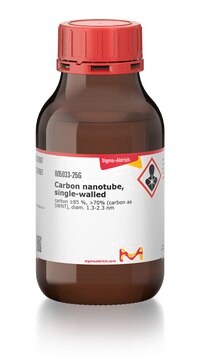750492
Carbon nanotube, single-walled
<3.5% Metal Catalyst, avg. no. of layers, 1
Synonym(s):
PureTubes™, SWCNT, SWNT, Single wall carbon nanotube
About This Item
Recommended Products
Assay
30% (Metallic)
70% (Semiconducting)
form
solid
feature
avg. no. of layers 1
manufacturer/tradename
NanoIntegris, Inc.
L
0.3-5 μm
impurities
<3.5% Metal Catalyst
diameter
1.2-1.7 nm
mp
3652-3697 °C (lit.)
density
1.7-1.9 g/cm3 at 25 °C (lit.)
SMILES string
[C]
Looking for similar products? Visit Product Comparison Guide
General description
Application
Research applications include:
- Electronics
- Sensors
- Composites
- Energy Storage
- Study of Life Science systems
Preparation Note
Legal Information
Signal Word
Warning
Hazard Statements
Precautionary Statements
Hazard Classifications
Carc. 2 - Skin Sens. 1 - STOT RE 2
Storage Class Code
11 - Combustible Solids
WGK
WGK 3
Flash Point(F)
Not applicable
Flash Point(C)
Not applicable
Certificates of Analysis (COA)
Search for Certificates of Analysis (COA) by entering the products Lot/Batch Number. Lot and Batch Numbers can be found on a product’s label following the words ‘Lot’ or ‘Batch’.
Already Own This Product?
Find documentation for the products that you have recently purchased in the Document Library.
Customers Also Viewed
Articles
We presents an article concerning the applications of high-purity single-walled nanotubes in electronic and biomedical fields.
Single-Walled Carbon Nanotubes synthesized by the Super-Growth Method & their properties & applications, including dispersing SGCNTs, SGCNT-polymer composites & SGCNT-metal composites are discussed.
Carbon nanomaterials (CNMs), such as single-walled carbon nanotubes (SWCNTs), multi-walled carbon nanotubes (MWCNTs), and graphene (Figure 1), have diverse commercial applications including lighter and stronger composite materials, improved energy storage devices, more sensitive sensors, and smaller transistors.
Boron nitride nanotubes (BNNT) are close structural analogs of carbon nanotubes (CNT), which are high aspect ratio nanotubular material, where carbon atoms are alternately substituted by nitrogen and boron atoms.
Our team of scientists has experience in all areas of research including Life Science, Material Science, Chemical Synthesis, Chromatography, Analytical and many others.
Contact Technical Service





